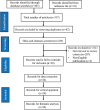Barriers to acceptance of vasectomy among married males in India: A systematic review
- PMID: 40547768
- PMCID: PMC12178483
- DOI: 10.4103/jfmpc.jfmpc_1785_24
Barriers to acceptance of vasectomy among married males in India: A systematic review
Abstract
Vasectomy was introduced under the National Family Planning Programme in 1954 to enhance male participation in family planning in India. Despite adopting the non-scalpel technique in 1992 to popularise vasectomy, its acceptance among married couples has declined from 3.31% to 0.3% over the past 3 decades. This study aims to identify the barriers among the married male population in India for adopting vasectomy as a method of family planning. This systematic review was conducted following PRISMA guidelines after PROSPERO registration (CRD42023434518). Six electronic databases (MEDLINE, Embase, Global Health, Allied and Complementary Medicine, APA PsycInfo, and CAB Abstracts Archive) were searched using terms including "vasectomy", "barriers", and "India" for studies reporting the barriers to accepting vasectomy as a family planning method. Qualitative, quantitative, and mixed-method studies on Indian male populations, reported in English and published up to May 2023, were included. Quality assessments were conducted using the JBI Critical Appraisal Tools. Extracted data were analysed using a thematic synthesis. Twenty-four studies conducted across India were included in the systematic review (18 cross-sectional, 2 interview-based, 2 mixed-method, 1 case-control and 1 focus group discussion-based). Five themes of barriers were identified: fear, social issues, cultural issues, knowledge, and health system issues. Men feared undergoing a surgical procedure for sterilisation. They presumed the procedure would lead to loss of libido, physical weakness leading to income loss, and social stigma from community members. Health education and financial incentives are likely to increase vasectomy acceptance in India.
Keywords: Family planning services; India sterilisation; gender equality; male contraception; vasectomy.
Copyright: © 2025 Journal of Family Medicine and Primary Care.
Conflict of interest statement
There are no conflicts of interest.
Figures
Similar articles
-
Survivor, family and professional experiences of psychosocial interventions for sexual abuse and violence: a qualitative evidence synthesis.Cochrane Database Syst Rev. 2022 Oct 4;10(10):CD013648. doi: 10.1002/14651858.CD013648.pub2. Cochrane Database Syst Rev. 2022. PMID: 36194890 Free PMC article.
-
Eliciting adverse effects data from participants in clinical trials.Cochrane Database Syst Rev. 2018 Jan 16;1(1):MR000039. doi: 10.1002/14651858.MR000039.pub2. Cochrane Database Syst Rev. 2018. PMID: 29372930 Free PMC article.
-
Barriers and facilitators to access mental health services among refugee women in high-income countries: a systematic review.Syst Rev. 2022 Apr 6;11(1):62. doi: 10.1186/s13643-022-01936-1. Syst Rev. 2022. PMID: 35387680 Free PMC article.
-
How lived experiences of illness trajectories, burdens of treatment, and social inequalities shape service user and caregiver participation in health and social care: a theory-informed qualitative evidence synthesis.Health Soc Care Deliv Res. 2025 Jun;13(24):1-120. doi: 10.3310/HGTQ8159. Health Soc Care Deliv Res. 2025. PMID: 40548558
-
Factors that influence parents' and informal caregivers' views and practices regarding routine childhood vaccination: a qualitative evidence synthesis.Cochrane Database Syst Rev. 2021 Oct 27;10(10):CD013265. doi: 10.1002/14651858.CD013265.pub2. Cochrane Database Syst Rev. 2021. PMID: 34706066 Free PMC article.
References
-
- Harkavy O, Roy K. Emergence of the Indian national family planning program. In: Robinson WC, Ross JA, editors. The Global Family Planning Revolution:Three Decades of Population Policies and Programs. 1st ed. Washington DC: The World Bank; 2007. pp. 301–24.
-
- Santhya KG. Changing family planning scenario in India. WHO South-East Asia Region. 2004;8:68.
-
- Shrivastava PS, Shrivastava SR. A community-based study to assess the perceptions and barriers in utilization of no-scalpel vasectomy among married men in a rural area of South India. J Med Soc. 2020;34:139–43.
-
- Ram U, Ram F. Demographic Transition in India:Insights into Population Growth, Composition, and its Major Drivers. New York, USA: Oxford Research Encyclopedia of Global Public Health Oxford University Press; 2021.
-
- Vandali V, Desai BS. Population explosion and future consequences:A review. Int J Community Health Nurs. 2021;4:14–8.
Publication types
LinkOut - more resources
Full Text Sources
Miscellaneous

